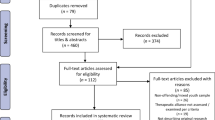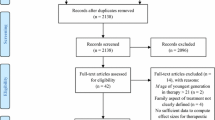Abstract
Research on relationship aspects in residential treatment of criminal young persons has largely been neglected despite the general finding in treatment research that such aspects have a large bearing on outcome. In this article, two studies of associations between relationship aspects and outcome in this treatment context are presented. In one of them, two treatment units practicing Aggression Replacement Training and CBT-techniques and 2 U with more conventional, relationally oriented treatment approaches were studied using process questionnaires and interviews. In the other study, adolescents who had been sentenced to treatment were interviewed about treatment experiences 1 year after release. Despite considerable attrition, several interesting findings were noted: The boys’ alliance ratings were associated with the collaborative aspect of the staff’s alliance ratings, but not with the bond aspect; warm and close staff feelings were related to negative outcome and the boys’ conceptions of the treatment model but not of the relationship with the staff was associated with positive outcome. The results suggest that a distinction should be made between a mutual bond aspect of the staff−boy relationship that was not related to outcome and a collaborative aspect which was related to outcome.




Similar content being viewed by others
References
Andrews, D. A., Zinger, I., Hoge, R. D., Bonta, J., Gendreau, P., & Cullen, F. T. (1990). Does correctional treatment work? A clinically relevant and psychologically informed metanalysis. Criminology, 28, 369–404.
Beutler, L. E. (1995). The germ theory myth and the myth of outcome homogeneity. Psychotherapy: Theory, Research, Practice, Training, 32, 489–494.
Chassin, L., Young, R. D., & Light, R. (1980). Evaluations of treatment techniques by delinquent and disturbed adolescents. Journal of Clinical Child Psychology, 9, 220–223.
Dowden, C., & Andrews, D. A. (2000). Effective correctional treatment and violent reoffending: A meta-analysis. Canadian Journal of Criminology, 42, 449–467.
Florsheim, P., & Shotorbani, S. (2000). Role of the working alliance in the treatment of delinquent boys in community-based programs. Journal of Clinical Child Psychology, 29, 94–108.
Gendreau, P. (1981). Treatment in corrections: Martinson was wrong. Canadian Psychology, 22, 332–338.
Gibbs, I., & Sinclair, I. (1999). Treatment and treatment outcomes in children’s homes. Child and Family Social Work, 4, 1–8.
Gold, M., & Osgood, D. W. (1992). Personality and peer influence in juvenile corrections. Contributions in criminology and penology. No. 38, London: Greenwood Press.
Goldstein, A., Glick, B., & Reiner, S. (1987). Aggression replacement training. Champaign, IL: Research Press.
Holmqvist, R., & Armelius, K. (2000). Countertransference feelings and the psychiatric staff’s self-image. Journal of Clinical Psychology, 56, 475–490.
Horvath, A. O. (2001). The alliance. Psychotherapy: Theory, Research, Practice, Training, 38, 365–372.
Horvath, A. O., & Bedi, R. P. (2002). The alliance. In: J. C. Norcross (Ed.), Psychotherapy relationships that work: Therapist contributions and responsiveness to patients. London: Oxford University Press.
Lipsey, M. W. (1992). Juvenile delinquency treatment: A meta-analytic inquiry inte the variability of effects. In: F. T. Cullen, & B. K. Appelgate (Eds.), Offender rehabilitation, effective correctional intervention. Aldershot: Dartmouth.
Luborsky, L. (2000). A pattern-setting therapeutic alliance study revisited. Psychotherapy Research, 10, 17–29.
Martinson, R. (1974). What works? Questions and answers about prison reform. The Public Interest, 35, 22–54.
McGuire, J., & Priestley, P. (1995). Reviewing ‘what works’: Past, present and future. In: J. McGuire (Ed.), What works: Reducing reoffending. New York: Wiley.
Mørch, W. -T., Snoek, J. E., & Syse, A. (1998). Frivillighed og tvang i behandling av barn og ungdom. Oslo: Ad Notam Gyldendal.
Norcross, J. C., & Lambert, M. J. (2006). The therapy relationship. In: I. J. C. Norcross, L. E. Beutler och, & R. F. Levant (Eds.), Evidence-based practices in mental health. Washington, DC: American Psychological Assocition.
O’Malley, F. (1990). Developing a therapeutic alliance in the hospital treatment of disturbed adolescents. Bulletin of the Menninger Clinic, 54, 13–24.
Ranieri, D. J. (1984). Motivating institutionalized adolescents for psychotherapy. Adolescence, 19, 925–933.
Rauktis, M. E., Vides de Andrade, A. R., Doucette, A., McDonough, L., & Reinhart, S. (2005). Treatment foster care and relationships: Understanding the role of therapeutic alliance between youth and treatment parent. International Journal of Child and Family Welfare, 8, 146–163.
Richards, I., & Sullivan, A. (1996). Psychotherapy for delinquents? Journal of Adolescence, 19, 63–73.
Rutter, M., Giller, H., & Hagell, A. (1998). Antisocial behavior by young people. Cambridge: Cambridge University Press.
Scholte, E. M., & van der Ploeg, J. D. (2000). Exploring factors governing successful residential treatment of youngsters with serious behavioural difficulties. Childhood, 7, 129–153.
Sinclair, I. (1971). Hostels for probationers. London: HMSO.
Author information
Authors and Affiliations
Corresponding author
Rights and permissions
About this article
Cite this article
Holmqvist, R., Hill, T. & Lang, A. Treatment Alliance in Residential Treatment of Criminal Adolescents. Child Youth Care Forum 36, 163–178 (2007). https://doi.org/10.1007/s10566-007-9037-z
Received:
Accepted:
Published:
Issue Date:
DOI: https://doi.org/10.1007/s10566-007-9037-z




